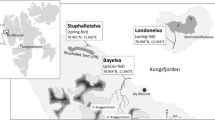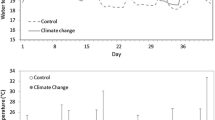Abstract
Chironomidae and Ceratopogonidae were tested experimentally for their responses to temperature. Three independent studies tested the effect of experimental temperatures (4, 14, and 24 °C) on emergence of midge faunas collected from littoral zones of three separate lakes, from profundal zones of three other lakes, and the littoral, sub-littoral and profundal zones of one lake. Results from these experiments indicate: that some taxa may achieve optimal development at cooler temperatures; that most taxa are cued for emergence by, and require, warmer temperatures; that exposure to temperatures too warm may result in developmental stress and sometimes death; that midge emergence events appeared more or less synchronous; and that emergences may be controlled by a threshold temperature as opposed to accumulation of degree-days. In these experiments, fauna collected from profundal zones exhibited high mortality rates when subjected to warm (24 °C) temperatures. In summation, some midge taxa may have relatively narrow optimal temperatures at which development and emergence can occur. Results from these experiments indicate that temperature directly impacts midges by regulating emergence and survival which may affect subfossil abundances and analyses typical with paleoreconstructions. Responses are similar to those predicted in paleoenvironmental inference modeling studies, and support the continued use of midges as paleotemperature indicators.





Similar content being viewed by others
References
Barley EM, Walker IR, Kurek J, Cwynar LC, Mathewes RW, Gajewski K, Finney BP (2006) A northwest North American training set: distribution of freshwater midges in relation to air temperature and lake depth. J Paleolimnol 36:295–314
Broderson KP, Pedersen O, Walker IR, Jensen MT (2008) Respiration of midges (Diptera; Chironomidae) in British Columbian lakes: oxy-regulation, temperature and their role as palaeo-indicators. Freshw Biol 53:593–602
Brooks SJ, Axford Y, Heiri O, Langdon PG, Larocque-Tobler I (2012) Chironomids can be reliable proxies for Holocene temperatures. A comment on Velle et al. (2010). Holocene 22:1495–1500
Eggermont H, Heiri O (2012) The chironomid-temperature relationship: expression in nature and palaeoenvironmental implications. Biol Rev (Camb) 87:430–456
Eggermont H, Heiri O, Verschuren D (2006) Fossil Chironomidae (Insecta: Diptera) as quantitative indicators of past salinity in African lakes. Quat Sci Rev 25:1966–1994
Hågvar S, Østbye E (1973) Notes on some winter-active Chironomidae. Nor ent Tidsskr 20:253–257
Hann BJ, Warner BG, Warwick WF (1992) Aquatic invertebrates and climate change: a comment on Walker et al. (1991). Can J Fish Aquat Sci 49:1274–1276
Hilsenhoff WL (1966) The biology of Chironomus plumosus (Diptera: Chironomidae) in Lake Winnebago, Wisconsin. Ann Entomol Soc Am 59:465–473
Korhola A, Olander H, Blom T (2000) Cladoceran and chironomid assemblages as quantitative indicators of water depth in subarctic Fennoscandian lakes. J Paleolimnol 24:43–54
Luoto TP (2011) The relationship between water quality and chironomid distribution in Finland—a new assemblage-based tool for assessments of long-term nutrient dynamics. Ecol Indicators 11:255–262
Oliver DR (1981) Chapter 29. Chironomidae. In: McAlpine JF, Peterson BV, Shewell GE, Teskey HJ, Vockeroth JR, Wood DM (coordinators) Manual of Nearctic Diptera. Vol 1. Monograph 27. Agric Can, Ottawa, Ontario, Canada, pp 423–458
Pinder LCV (1978) A key to adult males of British Chironomidae. Freshw Biol Assoc Sci Publ No. 37
Schoonmaker PK, Foster DR (1991) Some implications of paleoecology for contemporary ecology. Bot Rev (Camb) 57:204–245
Velle G, Brodersen KP, Birks HJB, Willassen E (2010) Midges as quantitative temperature indicator species: lessons for palaeoecology. Holocene 20:989–1002
Velle G, Brodersen KP, Birks HJB, Willassen E (2012) Inconsistent results should not be overlooked: a reply to Brooks et al. (2012). Holocene 22:1501–1508
Walker IR, Mathewes RW (1989) Chironomidae (Diptera) remains in surficial lake sediments from the Canadian Cordillera: analysis of the fauna across an altitudinal gradient. J Paleolimnol 2:61–80
Walker IR, Wilson SE, Smol JP (1995) Chironomidae (Diptera): quantitative palaeosalinity indicators for lakes of western Canada. Can J Fish Aquat Sci 52:950–960
Woodward CA, Shulmeister J (2006) New Zealand chironomids as proxies for human-induced and natural environmental change: transfer functions for temperature and lake production (chlorophyll a). J Paleolimnol 36:407–429
Zhang E, Jones R, Bedford A, Langdon P, Tang H (2007) A chironomid-based salinity inference model from lakes on the Tibetan Plateau. J Paleolimnol 38:477–491
Acknowledgments
We thank Nicole Pyett for her assistance in the field and Dr. Bohdan Bilyj for help with adult midge identifications. We also thank LeeAnn Fishback and all personnel (students, researchers and staff) at the Churchill Northern Studies Centre for logistical support and for providing a stimulating work environment. We acknowledge NSERC (Natural Sciences and Engineering Research Council) and the University of British Columbia, Okanagan Campus for financial support of this research.
Author information
Authors and Affiliations
Corresponding author
Rights and permissions
About this article
Cite this article
Dickson, T.R., Walker, I.R. Midge (Diptera: Chironomidae and Ceratopogonidae) emergence responses to temperature: experiments to assess midges’ capacity as paleotemperature indicators. J Paleolimnol 53, 165–176 (2015). https://doi.org/10.1007/s10933-014-9814-2
Received:
Accepted:
Published:
Issue Date:
DOI: https://doi.org/10.1007/s10933-014-9814-2




